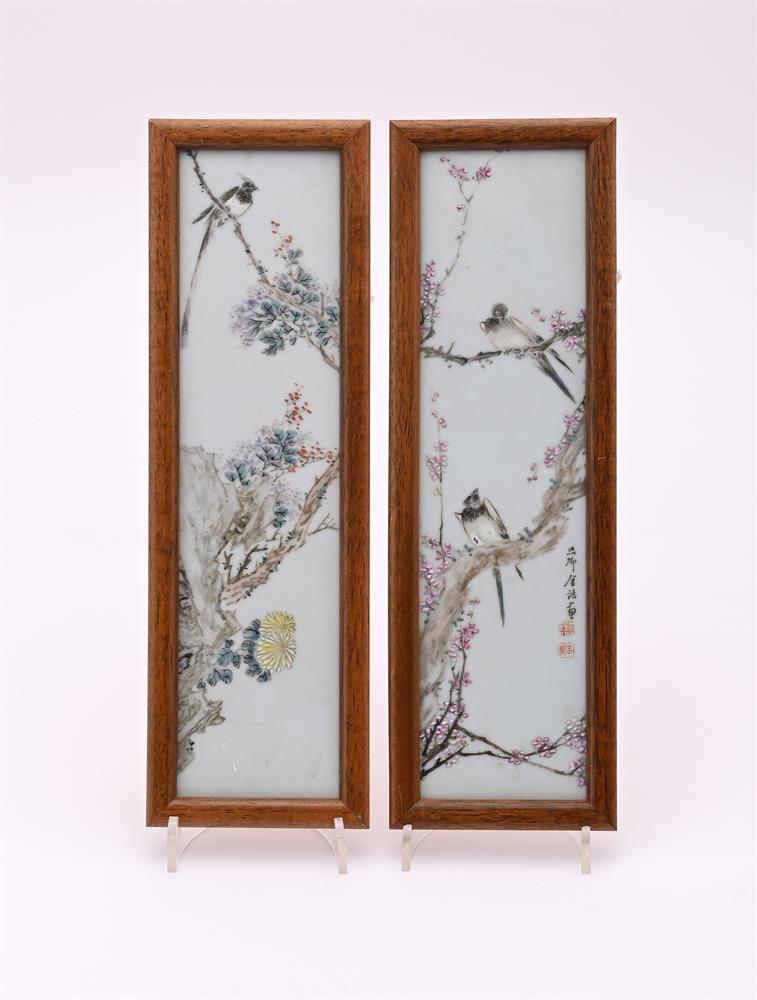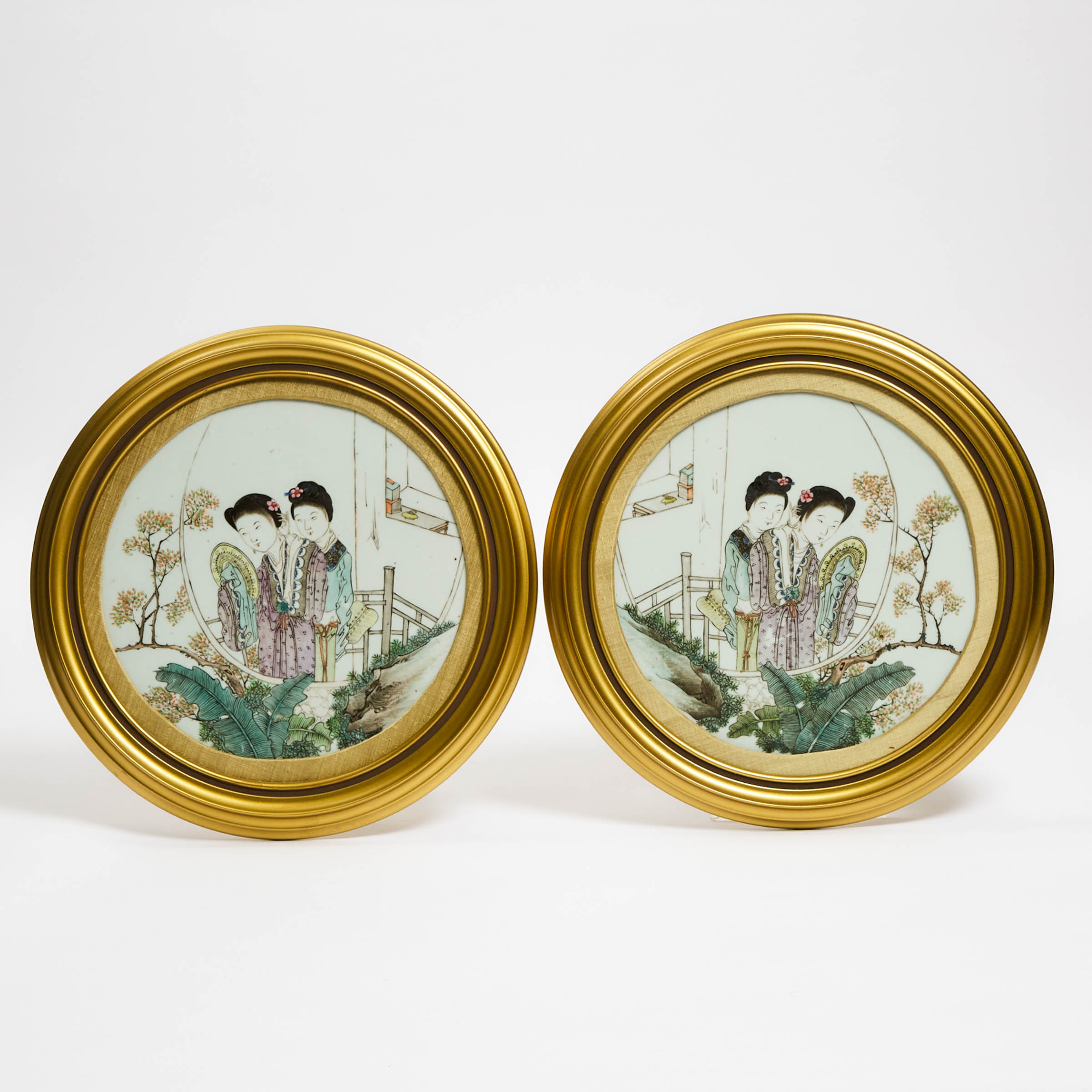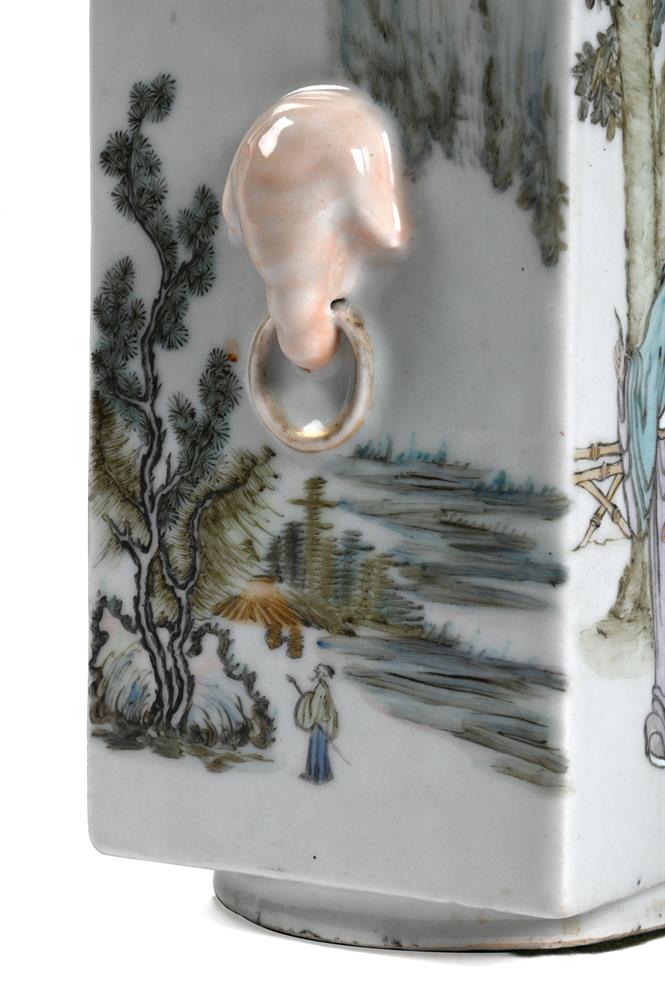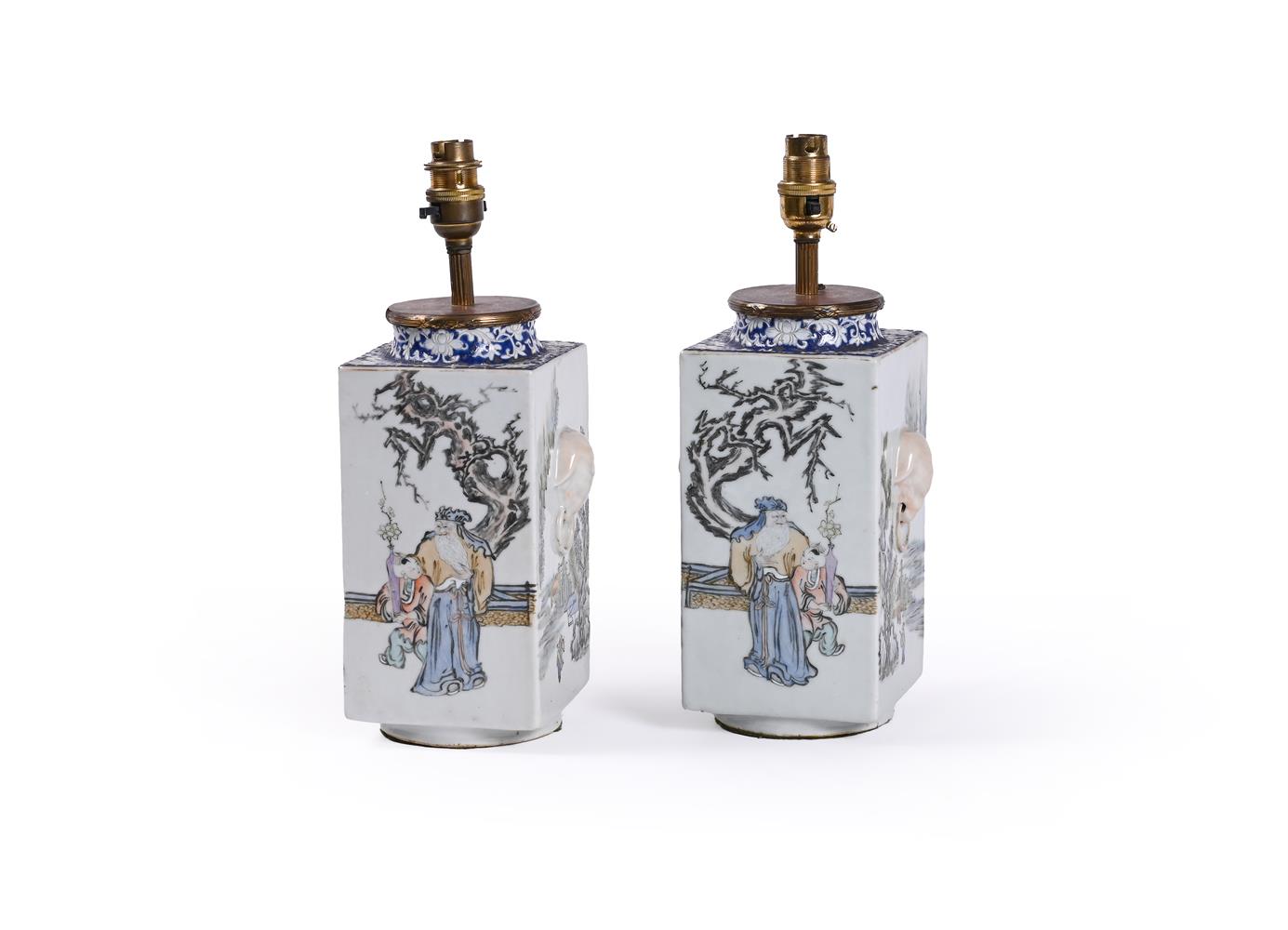Lot details Please note this Lot is to be sold at No Reserve. 本拍品不設底價 China, Jingdezhen, first half of the 20th century. Each well decorated in mirror image with Shoulao surrounded by boy attendants holding objects including a book, a lingzhi fungus, and a ruyi scepter under a gnarled pine tree amid colorful shrubbery, above the slightly bulbous mid-section with a bird perched on a branch amid leafy floral sprays, the lower section with four spotted deer in a meadow with a pine tree and rockwork. The vases with several inscriptions as well as an artist signature and dating, the bases with iron-red six-character studio marks. (2) Inscriptions: Each vase, to the top section, signed and dated ‘Xu Shanqin on a summer day in the Year of Gengzi’, and inscribed ‘collect books to educate the descendants’, one seal. To the mid-section, ‘in the eighth year of the period, painted in Zhushan’, one seal. To the lower section, ‘to repay a debt’, one seal. To the base, ‘Jiangxi Ciye Gongsi’. Provenance: French trade. Condition: Very good condition with minor wear and firing irregularities, occasional light scratches, little rubbing to enamels. Weight: 3,217 g and 3,263 g Dimensions: Height 41.8 cm and 41.9 cm Please click here to read the full description Xu Shanqin was a Chinese porcelain artist who was active during the late 19th and early 20th century and specialized in qianjiang painting. The Jiangxi Porcelain Company (or Jiangxi Ciye Gongsi) is the most well-known Chinese porcelain studio of the first half of the 20th century, located in Jingdezhen. It was established in circa 1910 as a large semi-government company funded by private owners and the five provinces of Hebei, Hubei, Jiangsu, Anhui, and Jiangxi. It is located near the Zhushan – the Pearl Hill – adjacent to the former Imperial porcelain workshops. It is often said that the Jiangxi Porcelain Company of the early 20th century replaced the Imperial kilns, making porcelains for the court in the last years of the Qing Dynasty. Qianjiang is a term used to describe a type of over-glaze enameled ware that was very popular during the Late Qing/Early Republican Period. The term Qianjiang cai (enamels) or Qianjiang porcelain was only coined in the 1950s. Prior to that, annals or commentaries in the late Qing and Republican periods did not classify it as a new distinctive type of over-glaze enamel decorative technique on porcelain. The term was initially used to describe a distinct style of landscape painting by the Yuan master Huang Gongwang. It is typified by the use of a particular color scheme: varying ink tones for outlines and reddish-brown for other aspects such as foliage, flowing water, mountain shades etc. The term was subsequently used to describe a porcelain painting style that used similar techniques but with additional colors such as aquamarine, moss green, pale blue, red and light pink. The relationship between qianjiang and fencai painting has caused quite a bit of confusion. In terms of the decorating medium, qianjiang utilizes fencai enamels. The main difference is actually the source of inspiration for the painting because the Qianjiang school draws its inspiration from the Chinese literati style, whereas the typical fencai work is more akin to gongbi painting. For fencai painting, the areas within the outlines of the motif are first applied with an arsenic-based opaque white pigment. The deeper and lighter tones are then obtained by mixing the enamels with different amounts of this opaque substance. For Qianjiang, the enamels are applied directly without the opaque white pigment. Hence, the enamels are thin and lack tonal gradations, especially on the early qianjiang works. 点此阅读中文翻译 (Chinese Translation) 一對淺絳彩花觚 中國,景德鎮,二十世紀上半葉。兩個花觚上的圖案對稱,蒼天老宋下坐著壽老,四周圍著小童,一個小童坐在他的膝蓋上,一個手裏拿一本書,一個手裏一株靈芝,另一個手裏拿著如意。中間飾花卉紋。花觚下部有四隻梅花鹿,草地上有鬆樹和岩石。花觚上有數個款識以及藝術家簽名和年代,底座上有礬紅釉六字“江西瓷業公司”。 (2) 款識: 結草銜花;江西瓷業公司 ;藏書教子孫,庚子年夏日徐善琴作;民國八年畫於珠山。 來源:法國古玩交易。 品相:狀況極好,有輕微磨損和燒製不規則,局部有輕微劃痕,琺瑯上有輕微摩擦。 重量:分別為3,217克與3
Lot details Please note this Lot is to be sold at No Reserve. 本拍品不設底價 China, Jingdezhen, first half of the 20th century. Each well decorated in mirror image with Shoulao surrounded by boy attendants holding objects including a book, a lingzhi fungus, and a ruyi scepter under a gnarled pine tree amid colorful shrubbery, above the slightly bulbous mid-section with a bird perched on a branch amid leafy floral sprays, the lower section with four spotted deer in a meadow with a pine tree and rockwork. The vases with several inscriptions as well as an artist signature and dating, the bases with iron-red six-character studio marks. (2) Inscriptions: Each vase, to the top section, signed and dated ‘Xu Shanqin on a summer day in the Year of Gengzi’, and inscribed ‘collect books to educate the descendants’, one seal. To the mid-section, ‘in the eighth year of the period, painted in Zhushan’, one seal. To the lower section, ‘to repay a debt’, one seal. To the base, ‘Jiangxi Ciye Gongsi’. Provenance: French trade. Condition: Very good condition with minor wear and firing irregularities, occasional light scratches, little rubbing to enamels. Weight: 3,217 g and 3,263 g Dimensions: Height 41.8 cm and 41.9 cm Please click here to read the full description Xu Shanqin was a Chinese porcelain artist who was active during the late 19th and early 20th century and specialized in qianjiang painting. The Jiangxi Porcelain Company (or Jiangxi Ciye Gongsi) is the most well-known Chinese porcelain studio of the first half of the 20th century, located in Jingdezhen. It was established in circa 1910 as a large semi-government company funded by private owners and the five provinces of Hebei, Hubei, Jiangsu, Anhui, and Jiangxi. It is located near the Zhushan – the Pearl Hill – adjacent to the former Imperial porcelain workshops. It is often said that the Jiangxi Porcelain Company of the early 20th century replaced the Imperial kilns, making porcelains for the court in the last years of the Qing Dynasty. Qianjiang is a term used to describe a type of over-glaze enameled ware that was very popular during the Late Qing/Early Republican Period. The term Qianjiang cai (enamels) or Qianjiang porcelain was only coined in the 1950s. Prior to that, annals or commentaries in the late Qing and Republican periods did not classify it as a new distinctive type of over-glaze enamel decorative technique on porcelain. The term was initially used to describe a distinct style of landscape painting by the Yuan master Huang Gongwang. It is typified by the use of a particular color scheme: varying ink tones for outlines and reddish-brown for other aspects such as foliage, flowing water, mountain shades etc. The term was subsequently used to describe a porcelain painting style that used similar techniques but with additional colors such as aquamarine, moss green, pale blue, red and light pink. The relationship between qianjiang and fencai painting has caused quite a bit of confusion. In terms of the decorating medium, qianjiang utilizes fencai enamels. The main difference is actually the source of inspiration for the painting because the Qianjiang school draws its inspiration from the Chinese literati style, whereas the typical fencai work is more akin to gongbi painting. For fencai painting, the areas within the outlines of the motif are first applied with an arsenic-based opaque white pigment. The deeper and lighter tones are then obtained by mixing the enamels with different amounts of this opaque substance. For Qianjiang, the enamels are applied directly without the opaque white pigment. Hence, the enamels are thin and lack tonal gradations, especially on the early qianjiang works. 点此阅读中文翻译 (Chinese Translation) 一對淺絳彩花觚 中國,景德鎮,二十世紀上半葉。兩個花觚上的圖案對稱,蒼天老宋下坐著壽老,四周圍著小童,一個小童坐在他的膝蓋上,一個手裏拿一本書,一個手裏一株靈芝,另一個手裏拿著如意。中間飾花卉紋。花觚下部有四隻梅花鹿,草地上有鬆樹和岩石。花觚上有數個款識以及藝術家簽名和年代,底座上有礬紅釉六字“江西瓷業公司”。 (2) 款識: 結草銜花;江西瓷業公司 ;藏書教子孫,庚子年夏日徐善琴作;民國八年畫於珠山。 來源:法國古玩交易。 品相:狀況極好,有輕微磨損和燒製不規則,局部有輕微劃痕,琺瑯上有輕微摩擦。 重量:分別為3,217克與3














Try LotSearch and its premium features for 7 days - without any costs!
Be notified automatically about new items in upcoming auctions.
Create an alert